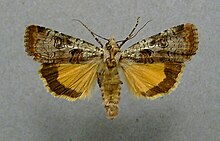Silver-gray gang owl
| Silver-gray gang owl | ||||||||||||
|---|---|---|---|---|---|---|---|---|---|---|---|---|

Silver-gray owl ( Epilecta linogrisea ) |
||||||||||||
| Systematics | ||||||||||||
|
||||||||||||
| Scientific name | ||||||||||||
| Epilecta linogrisea | ||||||||||||
| ( Denis & Schiffermüller , 1775) |
The silver- gray gang owl ( Epilecta linogrisea ), also called dry grass bush gang owl or forest steppe gang owl , is a butterfly ( moth ) from the family of owls (Noctuidae).
features
butterfly
The moths reach a wingspan of 33 to 41 millimeters. The forewings of newly hatched specimens are blue-gray or steel-gray and quickly turn whitish to silver-gray, darkening towards the Kostal margin. The f. lutosa has more yellow-gray and more uniformly colored fore wings. The lower part of the middle field towards the dorsum and the border area are tinted purple or reddish brown. The transverse lines are wavy and drawn twice, but indistinct. Ring and kidney defects are outlined in black with a red-brown spot in the center. The hind wings are yellow with a dark brown to black outer edge, without a center point.
Egg, caterpillar, pupa
The eggs are spherical with strong longitudinal ribs and white-yellow in color, as well as a red spotted band in the upper third. The lower pole is severely flattened. The caterpillars have a purple-brown basic color with a fine, darkly bordered, white topline as well as white secondary ridge lines that are reddish below. There are clear black wedge marks between the lines. The relatively slim doll is shiny brown and has two fine tips on the cremaster .
Similar species
The color differs from other band owls, which are less colorfully drawn, e.g. B. the
- Narrow-winged gang owl ( Noctua orbona )
- Broad-winged gang owl ( Noctua comes )
- House mother ( Noctua pronuba )
- Variegated gang owl ( Noctua fimbriata )
Geographical distribution and habitat
The species occurs widespread in Central and Southern Europe to southern Russia, also in Northwest Africa and Western Asia (Turkey, Syria, Lebanon, Israel) and the Caucasus region as far as Turkmenistan. In the north it extends to southern Scandinavia and the Baltic States (only an isolated occurrence there on the island of Ruhnu, Estonia). It is absent in the British Isles. The silver-gray band owl prefers warm dry and open areas with mostly sandy soil. In Central Europe it occurs only in the plains up to the low mountain ranges. In southern Europe, however, it rises up to 2200 m.
Way of life
The silver-gray band owl forms one generation per year in Central Europe, whose moths fly between July and early September. In southern Europe, the moths fly from June to September; but they are taking a summer break here. The moths are nocturnal and also fly to artificial light sources . They visit flowers and also get the bait . The caterpillars can usually be found from October. They feed on the leaves of various herbaceous plants (e.g. red foxglove ( Digitalis purpurea ) and primroses ( Primula )) and "grasses" ( Poaceae ). The adult caterpillars rest hidden during the day and come out of their hiding places to eat at night. They overwinter and pupate in an earth cocoon in April of the following year.
Danger
The species is classified in category 3 (endangered) on the Red List of Threatened Species .
swell
Individual evidence
- ↑ Red lists at Science4you
- ↑ a b c Fibiger (1993: p.92 / 3)
- ↑ a b Forster & Wohlfahrt (1971: p.38)
- ↑ AV Sviridov, TA Trofimova, MV Uskov, AV Mukhanov, LE Lobkova, VI Shchurov, EV Shutova, IV Kuznetsov, Yu. A. Lovtsova, PN Korzhov, VS Okulov and MA Klepikov: Noctuid Moths (Lepidoptera) new for different areas of the Russia. 2. Eversmannia, 7/8: 46-68, 2006 PDF
- ↑ VD Kravchenko, M. Fibiger, J. Mooser and GC Muller: The Noctuidae of Israel (Lepidoptera: Noctuidae). SHILAP Revista de Lepidopterología, 34 (136): 353-370, Madrid, 2006 PDF ( page no longer available , search in web archives ) Info: The link was automatically marked as defective. Please check the link according to the instructions and then remove this notice.
- ↑ Povilas Ivinskis and Jan Miatleuski. Data on Noctuidae 8Lepidoptera) of Turkmenistan. Acta Zoologica Lituanica, 9 (19): 201-208, 1999 ISSN 1392-1657 PDF ( page no longer available , search in web archives ) Info: The link was automatically marked as defective. Please check the link according to the instructions and then remove this notice.
- ↑ A. Šulcs, J. and P. Viidalepp Ivinskis: 1. Supplement to the spread of large butterflies in the Baltics (Lepidoptera). German Entomological Journal, 28 (1-3): 123-146, 1981 doi : 10.1002 / mmnd.19810280114
- ↑ a b Axel Steiner in Ebert (1998: pp. 384–387)
- ↑ Manfred Koch : We identify butterflies. Volume 3: Owls. 2nd, expanded edition. Neumann, Leipzig / Radebeul 1972, DNB 760072930 .
- ↑ Federal Agency for Nature Conservation (Ed.): Red List of Endangered Animals in Germany. Landwirtschaftsverlag, Münster 1998, ISBN 3-89624-110-9
literature
- Günter Ebert (Ed.): The butterflies of Baden-Württemberg . Volume 7, Nachtfalter V. Ulmer Verlag Stuttgart 1998, ISBN 3-8001-3500-0
- Michael Fibiger: Noctuinae II. - Noctuidae Europaeae, Volume 2. Entomological Press, Sorø, 1993, ISBN 87-89430-02-6
- Walter Forster , Theodor A. Wohlfahrt : The butterflies of Central Europe. Volume 4: Owls. (Noctuidae). Franckh'sche Verlagshandlung, Stuttgart 1971, ISBN 3-440-03752-5 .
Web links
- www.lepiforum.de Photos
- www.nic.funet.fi dissemination
- www.schmetterlinge-deutschlands.de Endangerment
- www.faunaeur.org Taxonomy (English)
